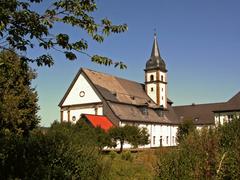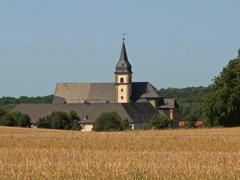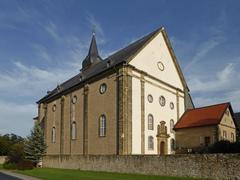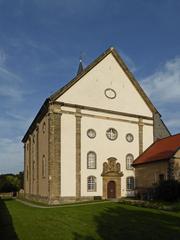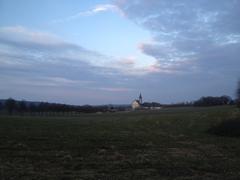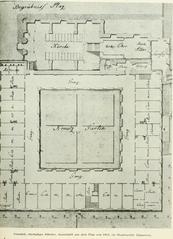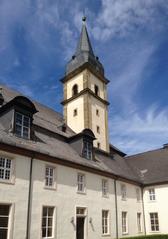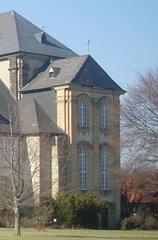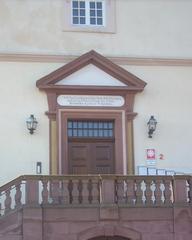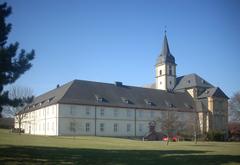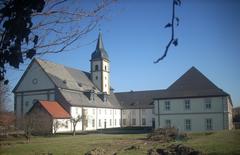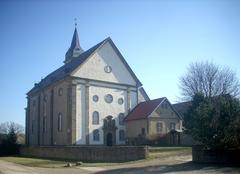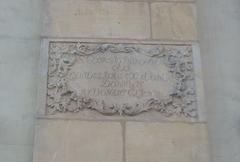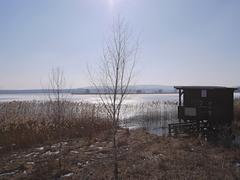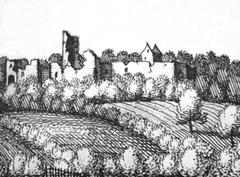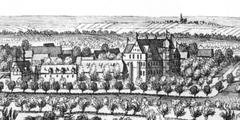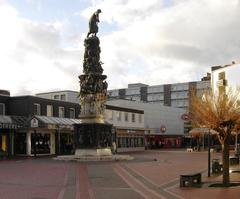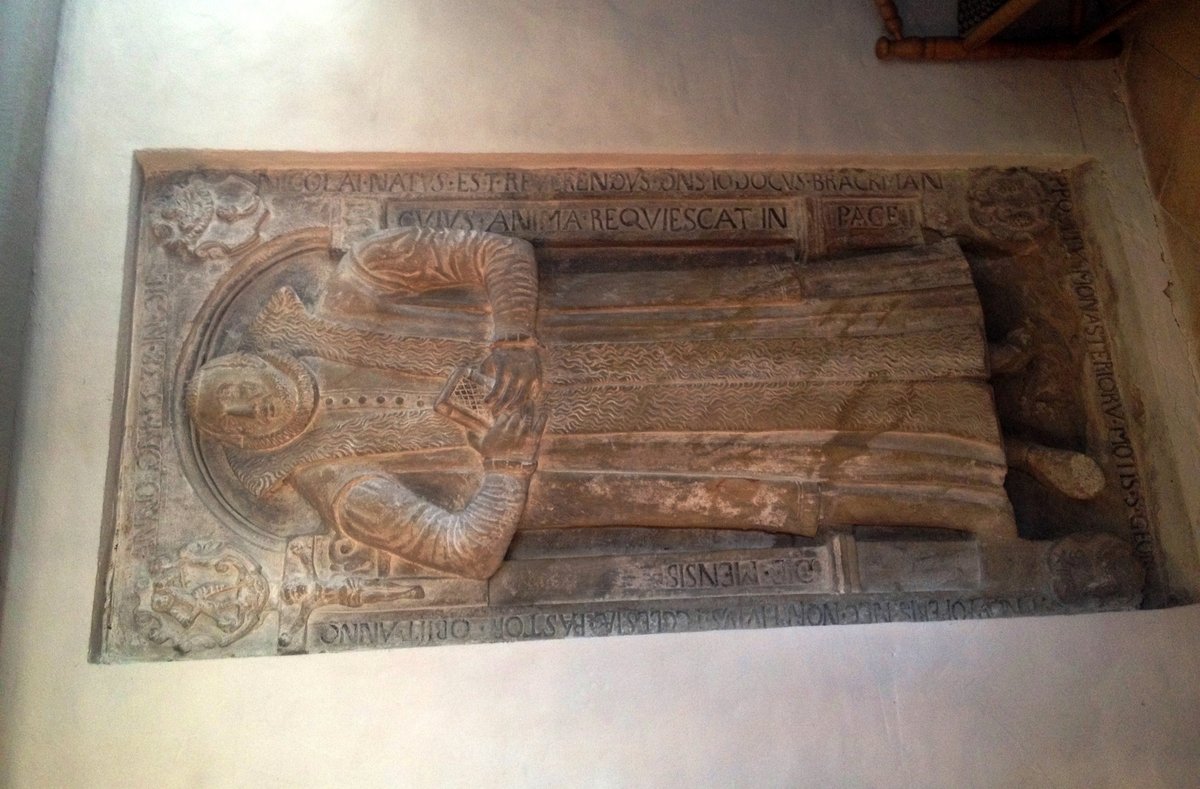
Visiting Klosterkirche St. Georg: History, Tickets, and Travel Tips
Date: 01/08/2024
Introduction
Klosterkirche St. Georg, located in Heere, Germany, is a destination that combines historical depth with architectural splendor. Originally part of the Benedictine Abbey of St. George, the church has stood since the early 12th century, marking it as a significant religious site. The abbey’s foundation was influenced by the Hirsau and Cluniac reforms, which aimed to rejuvenate monastic life (Wikipedia). Over the centuries, Klosterkirche St. Georg has undergone architectural transformations, incorporating Romanesque, Gothic, and Baroque elements, with notable contributions from artists such as Egid Quirin Asam (Kloster Weltenburg). This guide aims to provide comprehensive visitor information, including historical context, visiting hours, ticket prices, and tips to enhance your experience. Whether you are a history enthusiast, an art lover, or simply a curious traveler, Klosterkirche St. Georg offers a rich tapestry of cultural and spiritual heritage.
Table of Contents
- Introduction
- Historical Background
- Visitor Information
- Cultural and Artistic Contributions
- Visitor Experience
- FAQ
- Conclusion
Historical Background
Foundation and Early History
Klosterkirche St. Georg is part of the Benedictine Abbey of St. George, founded in the early 12th century. The abbey’s establishment was closely tied to the broader movement of Benedictine reform, influenced by the Hirsau Reform and the Cluniac Reform, which sought to return monastic life to its original ascetic and communal ideals (Wikipedia).
Architectural Development
The construction of the Klosterkirche St. Georg began in the early 12th century, with the initial chapel being dedicated on June 24, 1085. The church’s architecture reflects the Romanesque style, later incorporating elements of Gothic and Baroque architecture. Notably, the high altar, a masterpiece of Baroque art, was completed in 1734 by Egid Quirin Asam (Kloster Weltenburg).
Significance in the Middle Ages
During the Middle Ages, Klosterkirche St. Georg played a crucial role in the religious and cultural life of the region. It was a center of learning, spiritual guidance, and pilgrimage, attracting monks and scholars from across Europe (Wikipedia).
Challenges and Resilience
The abbey faced numerous challenges, including natural disasters like flooding and ice drift. Despite these adversities, it managed to thrive, thanks to the resilience of its monastic community (Kloster Weltenburg).
Reformation and Secularization
The Reformation in the 16th century led to the dissolution of many monastic communities, including Klosterkirche St. Georg in 1536. The monastic community relocated to Villingen in Austria (Wikipedia).
Post-Reformation Period
Efforts to re-establish the monastic community during the Thirty Years’ War were unsuccessful. The abbey and church were destroyed by fire in 1633. The ruins were later used as a quarry for rebuilding the town of St. Georgen im Schwarzwald after a fire in 1865 (Wikipedia).
Visitor Information
Visiting Hours and Tickets
Klosterkirche St. Georg is open to visitors year-round. Visiting hours vary seasonally, so it is advisable to check the official website for the most up-to-date information. Tickets can be purchased at the visitor center or online. Discounts are available for groups and students.
Guided Tours
Guided tours are available and highly recommended for those who wish to gain deeper insights into the church’s history and architectural significance. Tours are conducted in multiple languages and can be booked in advance.
Nearby Attractions
While in Heere, visitors can also explore other historical sites such as the Heere Castle and the local museum. The town offers a variety of dining and shopping options, making it a perfect day trip destination.
Cultural and Artistic Contributions
Baroque Architecture
The Klosterkirche St. Georg in Weltenburg is a quintessential example of Baroque architecture, a style that flourished in Europe from the late 16th century to the early 18th century. The church’s construction began in 1716 and was completed in 1718, with the interior and façade finishing touches extending until 1735. The Baroque style is characterized by dramatic expressions, grandeur, and a sense of movement, all of which are evident in the design of Klosterkirche St. Georg (Waymarking).
Interior Design and Frescoes
The interior of Klosterkirche St. Georg is equally impressive, featuring a rich array of frescoes, stucco decorations, and altarpieces. The frescoes, which were completed by 1735, depict various biblical scenes and saints, contributing to the church’s spiritual ambiance. The use of fresco-secco technique, where the painting is applied to a dry surface, is notable for its durability and vibrant colors.
The main altar is a focal point of the interior, adorned with sculptures and paintings that reflect the Baroque emphasis on theatricality and emotional engagement. The side altars and chapels are similarly decorated, each with its unique artistic elements that contribute to the overall aesthetic harmony of the church.
Sculptural Elements
Sculpture plays a significant role in the artistic significance of Klosterkirche St. Georg. The church features numerous statues of saints, angels, and biblical figures, all crafted with meticulous attention to detail. These sculptures are not merely decorative but serve to convey religious narratives and evoke a sense of reverence and awe among the visitors.
The pulpit, another highlight of the church’s interior, is an exquisite example of Baroque woodcarving. It is adorned with intricate reliefs and figures that illustrate scenes from the life of St. George, the church’s patron saint. The dynamic poses and expressive faces of the figures are characteristic of Baroque sculpture, emphasizing movement and emotion.
Artistic Contributions
Several renowned artists and craftsmen contributed to the creation of Klosterkirche St. Georg. The frescoes were painted by Cosmas Damian Asam, a prominent Baroque artist known for his dramatic and vivid style. His brother, Egid Quirin Asam, was responsible for the stucco work and sculptures, showcasing the collaborative nature of Baroque art (Reverberations).
The Asam brothers’ work is celebrated for its integration of architecture, painting, and sculpture, creating a cohesive and immersive artistic experience. Their contributions to Klosterkirche St. Georg are a testament to their skill and creativity, making the church a significant landmark in the history of Baroque art.
Visitor Experience
Practical Tips for Visitors
- Dress Code: As an active place of worship, visitors are expected to dress modestly and respectfully. This includes covering shoulders and knees and avoiding loud or disruptive behavior.
- Photography: Photography is generally allowed, but the use of flash and tripods may be restricted to protect the delicate frescoes and artworks. Visitors should follow any posted guidelines and respect the sanctity of the space.
- Accessibility: The church is accessible to visitors with mobility issues, with ramps and designated seating areas available. However, some areas, such as the upper galleries, may have limited access.
- Nearby Attractions: Klosterkirche St. Georg is located in the picturesque village of Weltenburg, which offers additional attractions such as the Weltenburg Abbey and the scenic Danube Gorge. Visitors can enjoy a leisurely stroll along the river, visit local cafes and shops, or take a boat tour to explore the natural beauty of the region.
Unique Events and Special Guided Tours
The church hosts a variety of special events throughout the year, including religious festivals, concerts, and community gatherings. Guided tours are available, offering detailed insights into the history, design, and significance of the church. These tours can be booked in advance through the official website or the church office.
Nearby Accommodations and Dining Options
- Accommodations: Visitors can stay at nearby hotels such as Hotel Chlosterhof Stein am Rhein or Hotel Rheinfels, both offering comfortable accommodations and excellent service.
- Dining Options: For dining, consider local restaurants like Zum Felsen or Restaurant Adler, where you can enjoy traditional Swiss cuisine.
FAQ
- What are the visiting hours for Klosterkirche St. Georg? The church is open daily, but specific hours for tours and services may vary. Check the official website for the latest updates.
- Are there guided tours available at Klosterkirche St. Georg? Yes, guided tours are available and can be booked in advance through the official website or the church office.
- Is there an admission fee for visiting Klosterkirche St. Georg? Admission is generally free, but donations are appreciated to support preservation efforts.
- What should I wear when visiting Klosterkirche St. Georg? Visitors are expected to dress modestly, covering shoulders and knees, as the church is an active place of worship.
Conclusion
In summary, Klosterkirche St. Georg in Heere, Germany, stands as a testament to the resilience and artistic achievements of its monastic community. From its foundation in the 12th century to its architectural evolution through Romanesque, Gothic, and Baroque styles, the church encapsulates a rich history that has endured despite numerous challenges, including natural disasters and the Reformation (Wikipedia). Today, visitors can explore its stunning interiors, marked by the Baroque artistry of the Asam brothers, and gain deeper insights through guided tours (Kloster Weltenburg). The church not only serves as a historical monument but also as a living cultural hub, hosting special events and offering a variety of nearby attractions in Heere. By planning your visit carefully and taking advantage of available resources, you can immerse yourself in the rich heritage of Klosterkirche St. Georg and create lasting memories.
References
- Wikipedia, 2024, Various authors https://en.wikipedia.org/wiki/St._George%27s_Abbey_in_the_Black_Forest
- Kloster Weltenburg, 2024, Official site https://www.kloster-weltenburg.de/en/abbey-church/kirche/high-altar/
- Kloster Weltenburg, 2024, Official site https://www.kloster-weltenburg.de/en/abbey-church/visitor-center/
- Touring Switzerland, 2024, Various authors https://www.touringswitzerland.com/saint-georges-abbey-stein-am-rhein-visitor-guide/
- St. George’s Abbey Museum, 2024, Official site https://www.klostersanktgeorgen.ch/kstg/en/home/besucherinformationen/visitor-information.html
- Reverberations, 2024, Official site https://www.reverberations.net/kloster-weltenburg-danube-river-cruise/
- Waymarking, 2024, Official site https://www.waymarking.com/waymarks/WME8ET_Klosterkirche_St_Georg_Weltenburg
- Culture Trip, 2024, Official site https://theculturetrip.com/europe/germany/articles/places-in-germany-for-history-lovers

